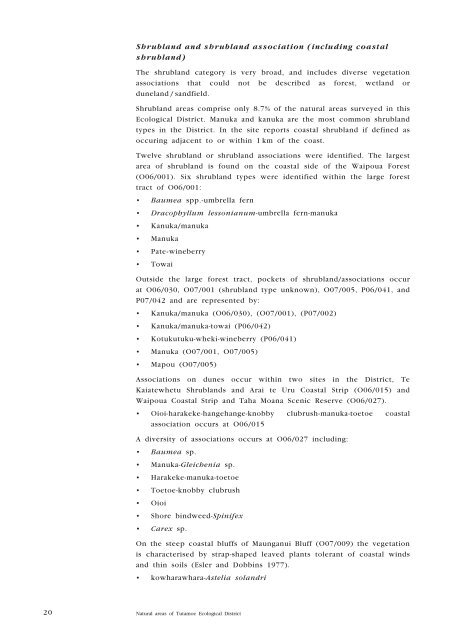Natural areas of Tutamoe Ecological District (3. Ecological character)
Natural areas of Tutamoe Ecological District (3. Ecological character)
Natural areas of Tutamoe Ecological District (3. Ecological character)
You also want an ePaper? Increase the reach of your titles
YUMPU automatically turns print PDFs into web optimized ePapers that Google loves.
Shrubland and shrubland association (including coastal<br />
shrubland)<br />
The shrubland category is very broad, and includes diverse vegetation<br />
associations that could not be described as forest, wetland or<br />
duneland / sandfield.<br />
Shrubland <strong>areas</strong> comprise only 8.7% <strong>of</strong> the natural <strong>areas</strong> surveyed in this<br />
<strong>Ecological</strong> <strong>District</strong>. Manuka and kanuka are the most common shrubland<br />
types in the <strong>District</strong>. In the site reports coastal shrubland if defined as<br />
occuring adjacent to or within 1 km <strong>of</strong> the coast.<br />
Twelve shrubland or shrubland associations were identified. The largest<br />
area <strong>of</strong> shrubland is found on the coastal side <strong>of</strong> the Waipoua Forest<br />
(O06/001). Six shrubland types were identified within the large forest<br />
tract <strong>of</strong> O06/001:<br />
• Baumea spp.-umbrella fern<br />
• Dracophyllum lessonianum-umbrella<br />
fern-manuka<br />
• Kanuka/manuka<br />
• Manuka<br />
• Pate-wineberry<br />
• Towai<br />
Outside the large forest tract, pockets <strong>of</strong> shrubland/associations occur<br />
at O06/030, O07/001 (shrubland type unknown), O07/005, P06/041, and<br />
P07/042 and are represented by:<br />
• Kanuka/manuka (O06/030), (O07/001), (P07/002)<br />
• Kanuka/manuka-towai (P06/042)<br />
• Kotukutuku-wheki-wineberry (P06/041)<br />
• Manuka (O07/001, O07/005)<br />
• Mapou (O07/005)<br />
Associations on dunes occur within two sites in the <strong>District</strong>, Te<br />
Kaiatewhetu Shrublands and Arai te Uru Coastal Strip (O06/015) and<br />
Waipoua Coastal Strip and Taha Moana Scenic Reserve (O06/027).<br />
• Oioi-harakeke-hangehange-knobby<br />
association occurs at O06/015<br />
clubrush-manuka-toetoe<br />
coastal<br />
A diversity <strong>of</strong> associations occurs at O06/027 including:<br />
• Baumea sp.<br />
• Manuka-Gleichenia<br />
sp.<br />
• Harakeke-manuka-toetoe<br />
• Toetoe-knobby clubrush<br />
• Oioi<br />
• Shore bindweed-Spinifex<br />
• Carex sp.<br />
On the steep coastal bluffs <strong>of</strong> Maunganui Bluff (O07/009) the vegetation<br />
is <strong>character</strong>ised by strap-shaped leaved plants tolerant <strong>of</strong> coastal winds<br />
and thin soils (Esler and Dobbins 1977).<br />
• kowharawhara-Astelia<br />
solandri<br />
20 <strong>Natural</strong> <strong>areas</strong> <strong>of</strong> <strong>Tutamoe</strong> <strong>Ecological</strong> <strong>District</strong>

















